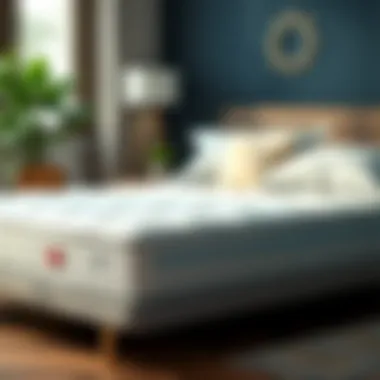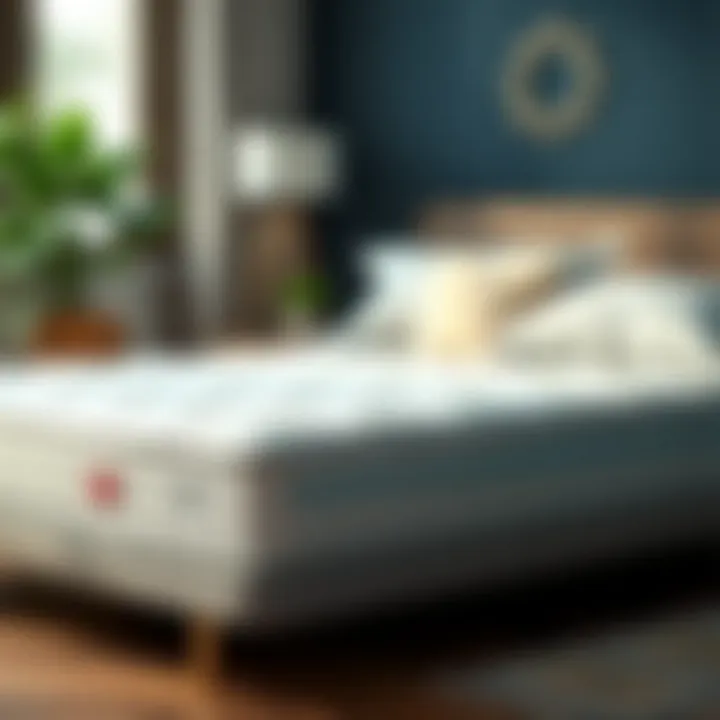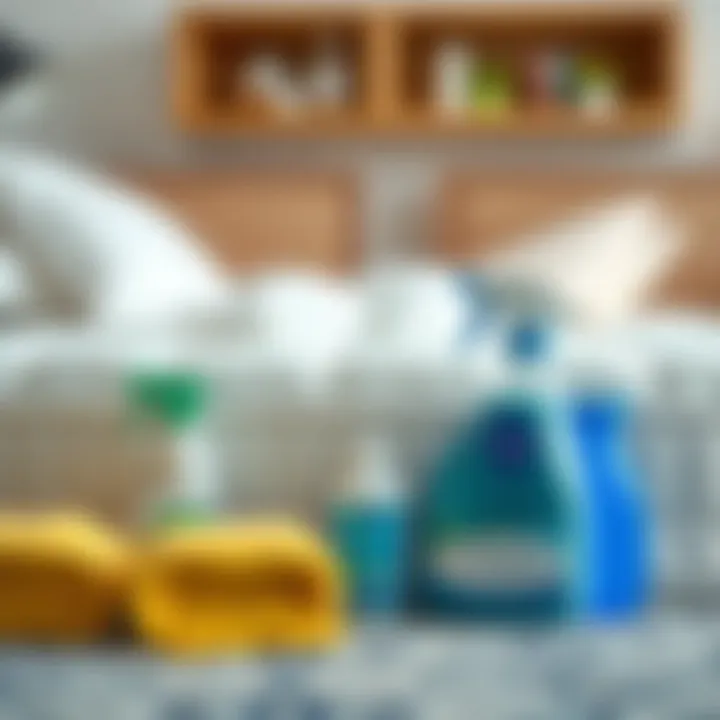Effective Mattress Cleaning Techniques for Hygiene


Intro
Maintaining a clean bed mattress isn't just about aesthetics; it's crucial for ensuring quality sleep and protecting your health. A good mattress can trap dust, allergens, and unpleasant odors over time, impacting your overall well-being. This article dives into a range of methodologies which can be applied to keep your bedding in tip-top shape.
In the following sections, we’ll explore various cleaning strategies, from natural methods using household items to specialized commercial products. We’ll also touch upon preventative measures that can ensure your mattress stays fresh and hygienic. Knowing how often to clean, recognizing the specific needs of different mattress materials, and understanding the importance of a clean sleeping environment will empower you as a homeowner to take control of your bedding maintenance.
So, whether you’re battling stubborn stains or merely looking to refresh your mattress, this guide aims to be your one-stop resource for mattress upkeep.
Understanding the Importance of Mattress Cleaning
Maintaining a clean mattress encompasses more than just aesthetic values; it touches upon pivotal aspects concerning health, comfort, and the longevity of your investment. The mattress is a home to various contaminants if neglected, including dust mites, allergens, and even bodily fluids. Cleaning it regularly ensures a hygienic sleeping environment, which is crucial given that we spend almost a third of our lives on our beds. A good mattress cleaning routine can significantly enhance your overall well-being.
Health Benefits of a Clean Mattress
A clean mattress vastly contributes to the reduction of health risks. For many, allergies can become a miserable part of life, often exacerbated by a mattress that hosts dust mites and their droppings. According to studies, dust mites can be a significant trigger for asthma and allergic reactions. By engaging in regular mattress cleaning, one can significantly reduce these triggers, leading to fewer allergy symptoms.
"A clean mattress is the foundation of good sleep; if you don't take care of it, it won't take care of you."
A focus on cleanliness not only enhances physical health but also plays a role in mental well-being. Knowing that you're sleeping on a fresh surface can enhance peace of mind, trivial as it may sound. It’s about creating an environment that contributes positively to your overall health.
Impact on Sleep Quality
On a nightly basis, the quality of our sleep can be greatly affected by our mattress condition. A dirty mattress can lead to discomfort due to allergens and odors, which in turn can disrupt sleep cycles. Realizing that you’re snoozing on a surface burdened with residues from the day can be distressing. Furthermore, a well-maintained mattress can help in regulating your body’s temperature, playing a crucial role as you snooze.
To optimize your sleep quality, consider the following:
- Vacuum your mattress regularly to eliminate excess dust.
- Use natural cleaners with pleasant scents to keep the surface fresh.
- Rotate the mattress frequently to promote even wear.
With such practices, you’re not just ensuring you get enough sleep; you’re also investing in restful, quality sleep—something all too essential yet often overlooked.
Extending Mattress Longevity
A major perk of keeping your mattress clean is its lifespan. Failing to properly care for your mattress can lead to quicker deterioration. By removing dirt and debris regularly, you’ll lessen the wear and tear on the materials of your mattress. Frequent cleanliness leads to a healthy environment where the mattress can retain its structural integrity. This will save you from frequent replacements, making mattress cleaning not just about immediate comfort but also about long-term savings.
Key practices include avoiding jumping on the bed, using a mattress protector, and ensuring proper ventilation in your sleeping area. All these little steps contribute to extending the life of your mattress and preserving its optimal shape and comfort.
Cleaning your mattress doesn’t seem too hefty a task when balanced against its many benefits. A clean mattress is pivotal for health, sleep quality, and durability. A proactive cleaning approach protects your investment and contributes to an overall healthier lifestyle.
Identifying Common Mattress Contaminants
Understanding the types of contaminants that can be found in your mattress is vital for maintaining both hygiene and comfort. An unclean mattress can be more than just a slight inconvenience; it can lead to serious health repercussions. From allergens that aggravate respiratory issues to stains that can compromise the integrity of your bedding, being aware of these common invaders allows homeowners to take informed action. Not only does this knowledge encourage regular maintenance, but it also plays a key role in enhancing sleep quality and prolonging the lifespan of the mattress.
Dust Mites and Allergens
Dust mites are microscopic creatures that thrive in warm, humid environments, making your mattress a perfect breeding ground. These tiny pests feed on dead skin cells and shed components like feces and body fragments, which can trigger allergic reactions and asthma in sensitive individuals. A clean mattress can greatly reduce dust mite populations, but that effort begins with proper identification.
- Symptoms of Dust Mite Allergies:
- Sneezing
- Runny or stuffy nose
- Itchy eyes
- Skin rashes
To keep dust mites at bay, consider washing your bedsheets and pillowcases weekly in hot water, and using allergen-proof covers. Regular vacuuming, preferably with a vacuum that has a HEPA filter, can also help protect against these unwelcome guests.
Bodily Fluids and Stains
It may not be the most pleasant topic, but let's face it: mattresses can absorb bodily fluids that lead to stubborn stains and unsanitary conditions. Whether it’s perspiration, saliva, or occasional spills, these fluids can accumulate over time, creating a breeding ground for bacteria and awkward smells.
- Common Sources of Stains:
- Sweat from hot summer nights
- Spills from bedtime snacks
- Accidents from pets or young children
To tackle these stains, immediate action is crucial. Blot up liquid spills with a clean cloth or paper towel then apply a suitable stain remover. However, be careful not to oversaturate; too much water could damage the mattress! Barriers like mattress protectors can be a wise investment to prevent future mishaps.
Odors and Bacteria
If your mattress has acquired a certain funky aroma, you're not alone. Foul odors are often the result of bacteria proliferation, stemming from sweat, spills, and even moisture from the air. This not only affects sleep quality but can also lead to discomfort or embarrassment when guests come to stay.
- Sources of Odors:
- Stale sweat after a long night
- Mold and mildew from dampness
- Food particles inviting pests
To freshen up your mattress, a sprinkling of baking soda can do wonders. Let it sit for several hours before vacuuming it off; this helps absorb odors and moisture, leaving your sleeping area smelling like a breath of fresh air. Additionally, maintaining good air circulation in the room can significantly deter bacterial growth.
"A clean mattress is not just a luxury—it's essential for good health and quality sleep."
In summary, recognizing the various contaminants lurking in your mattress helps equip you with the knowledge needed for ensure a healthier sleep environment. Investing your time in identifying and cleaning these issues will lead to better health, improved sleep, and longer-lasting bedding.
Essential Tools and Supplies for Mattress Cleaning


Cleaning a mattress isn’t just about making it look pretty; it’s a necessity for maintaining a healthy sleep environment. Equipping yourself with the right tools and supplies can save you time and effort, leading to a deeper clean and prolonging the lifespan of your mattress. Let’s delve into the essentials that every homeowner, interior design enthusiast, or party host should consider.
Vacuum Cleaners
Vacuum cleaners, without a doubt, are your first line of defense against dust mites, pet dander, and other unwelcome guests that have made your mattress their home. When selecting a vacuum, choose one with a HEPA filter; this specialized filter traps small particles, reducing allergens in the air.
Consider using a vacuum with a handheld attachment, as it helps reach those tricky corners and crevices with ease. You might also want to think about a vacuum cleaner with specific upholstery settings designed just for mattress cleaning. This tailored approach ensures that you’re not just moving dirt around but actually sucking it up!
To give your mattress a thorough vacuuming, start from the top and work your way down. The process should be slow and steady, allowing the vacuum sufficient time to pick up all the debris from the surface. Don’t skimp on vacuuming the sides and edges, as this is where a lot of particles accumulate.
Cleaning Solutions
When it comes to mattress care, using the right cleaning solutions can make or break your cleaning routine. Natural solutions like baking soda and vinegar can do wonders — they’re effective, affordable, and skip the harsh chemicals. Why spend an arm and a leg on commercial solutions when you can use something already in your pantry?
Baking soda is fantastic for absorbing odors, while white vinegar is known for its antibacterial properties. Mix these two together for a potent cleaning duo. Simply sprinkle baking soda across your mattress, let it sit for several hours (or overnight), and then vacuum it up. Follow with a light spray of diluted vinegar to help sanitize the mattress.
For tougher stains, consider an enzymatic cleaner — not only do they break down stains, but they also eliminate odors at their source. Just be sure to read labels and follow instructions carefully. A good bit of caution goes a long way, especially when tackling tough messes.
Stain Removal Tools
Some stains are harder to budge than a stubborn old penny. That's where specialized stain removal tools come into play. You don’t need to break the bank; just a few simple tools can be your best friends when it comes to mattress upkeep.
- Soft-bristled brush: Perfect for lifting dirt without being too abrasive on the fabric. Think of it as your gentle approach to grime.
- Microfiber cloths: These magic cloths trap dirt and don’t leave lint behind. An absolute must-have for blotting and scrubbing stains gently.
- Spray bottles: Fill them with your chosen cleaning solution for a controlled application. It keeps things neat and tidy; after all, nobody wants a cleaning disaster!
The effectiveness of these tools lies not just in their use but also in knowing when to apply each one. For instance, some stains may respond better to blotting rather than scrubbing, especially if the stain is fresh. Keeping a clean mattress isn’t just a task; it’s an art!
Remember, investing in the right tools and supplies is like laying the groundwork for a beautiful garden. With effort and care, your mattress can bloom into the clean sanctuary you desire.
Natural Cleaning Solutions for Mattresses
When it comes to maintaining a clean mattress, opting for natural cleaning solutions is not just an alternative; it’s often the most sensible choice. These solutions are generally less harsh compared to their chemical counterparts. They offer several benefits such as being environmentally friendly, safer for your health, and effective at tackling common mattress pollutants like dust mites, stains, and odors. Moreover, many natural ingredients can be found right in your kitchen, making them easily accessible and economical.
Baking Soda and Vinegar
Baking soda and vinegar are perhaps the dynamic duo in the realm of natural cleaning. Baking soda is a mild abrasive that can lift dirt, neutralize odors, and absorb moisture, while vinegar, being a powerful acid, effectively cuts through grime and disinfects surfaces. Together, they form a cleaning powerhouse.
To clean your mattress with this method:
- Sprinkle Baking Soda: Generously sprinkle baking soda over the surface of the mattress. Let it sit for a few hours or ideally overnight. This will give it time to absorb odors and moisture.
- Mix Vinegar Solution: In a spray bottle, mix equal parts white vinegar and water to create a simple cleaning spray.
- Spritz and Wipe: Lightly spritz the mattress with the vinegar solution, focusing on stained areas. Avoid soaking the mattress thoroughly, as excess moisture can lead to mold growth. Use a cloth to gently wipe the area down.
- Vacuum: After letting the baking soda sit and the vinegar dry, use a vacuum cleaner to remove all the baking soda along with any loosened dirt.
This method not only cleans but leaves the mattress smelling fresh, thanks to the natural deodorizing properties of baking soda.
"A clean mattress is a happy mattress."
Essential Oils
Integrating essential oils into your mattress cleaning routine can elevate the freshness factor significantly. Oils such as lavender, tea tree, and eucalyptus not only infuse a pleasant aroma but also possess antibacterial and antifungal properties.
To incorporate essential oils:
- Add to Baking Soda: Before applying baking soda, mix a few drops of your favorite essential oil directly into it. This will infuse the baking soda with the scent and properties of the oil.
- Make an Aromatic Spray: Combine water with a few drops of essential oil in a spray bottle. This can be spritzed on the mattress after cleaning, providing an inviting scent as well as a layer of disinfection.
Essential oils are particularly beneficial if you want to foster a calming environment in your bedroom. Lavender, for example, is renowned for promoting relaxation and can significantly enhance sleep quality.
Hydrogen Peroxide Applications
Hydrogen peroxide, a common household item, serves as an excellent natural cleaning agent. It is particularly effective for treating stubborn stains, including blood, sweat, and other bodily fluids. It’s important to note that hydrogen peroxide works best on light-colored fabrics, as it can sometimes cause discoloration on darker materials.
To use hydrogen peroxide effectively:
- Test the Fabric: Before applying it to the entire mattress, conduct a spot test on a hidden area to check for any adverse reactions.
- Create a Stain Treatment: Mix equal parts of hydrogen peroxide and water in a spray bottle.
- Apply to Spots: Spray directly on the stained areas and let it sit for approximately 10 minutes.
- Blot and Rinse: Use a clean cloth to blot the area. Follow up by wiping down the region with a damp cloth to remove any excess hydrogen peroxide.
Using hydrogen peroxide not only tackles stains effectively but also can kill bacteria and germs, contributing to a healthier sleeping environment.
The use of natural cleaning solutions for your mattress not only elevates hygiene levels but also enhances the longevity of the mattress material. By integrating these methods into your regular cleaning routine, you can ensure a fresh and clean sleeping environment.
Commercial Products for Mattress Care
When it comes to keeping your mattress in tip-top condition, commercial products can be invaluable. Though natural methods hold a place of significance, specialized commercial cleaners offer targeted solutions for persistent issues that often arise in sleep environments. These products are formulated to work effectively against various contaminants, providing a deeper clean while saving you time and effort.
Mattress Cleaners
Typically, a commercial mattress cleaner is designed specifically to eliminate dirt, dust, and allergens that may accumulate on or within your mattress. Many of these cleaners are crafted with both safety and efficacy in mind, often being free of harsh chemicals that could irritate sensitive skin. When choosing a cleaner, look for the following:
- Eco-friendly formulations: These cleaners not only sidestep harmful chemicals, but many also rely on plant-based ingredients, ensuring that you are taking care of both your mattress and the environment.
- Fast-drying properties: A cleaner that dries quickly allows you to get back to bed sooner, minimizing disruption in your routine.
Using a mattress cleaner begins with a thorough vacuuming of the entire surface, followed by the application of the cleaner as directed. This typically involves spraying, allowing it to sit for a few minutes, and then wiping or blotting with a clean cloth. This method helps in eliminating odors as well as bacteria.


Stain Removers
Accidental spills happen to the best of us, and that’s where stain removers come into play. Blood, sweat, or even food stains can become embedded in your mattress fabric, if not addressed promptly. Commercial stain removers extend beyond just beautifying the surface of the mattress; they penetrate deeply to lift and remove the stain without damaging the underlying materials.
When selecting a stain remover, consider the following aspects:
- Type of stain: Ensure that the product explicitly mentions its effectiveness against the specific stain type you are dealing with, whether it be organic like sweat, or synthetic like ink.
- Spot application convenience: Some cleaners come in spray bottles that allow easy targeted application, while others may require soaking and longer treatment times.
Utilizing a stain remover typically involves applying it directly onto the stained area, allowing it to work its magic based on the product's instructions, and then rinsing or blotting with cool water afterwards.
Protective Spray Solutions
To further safeguard your mattress from future mishaps, protective spray solutions can serve as a precautionary measure. These sprays form a barrier that repels moisture and prevents stains from adhering to the fabric. By using these products, homeowners can significantly prolong the life of their mattress.
When considering a protective spray, take note of:
- Non-toxic ingredients: A family-friendly option is crucial if you have children or pets at home.
- Durability of the barrier: Investigate how long the spray remains effective after application, as some may wear off after a certain number of washes or exposure to humidity.
Typically, application is straightforward – simply spray evenly all over the mattress surface, allow to dry, and then you are good to go. Hunting for spills becomes less of a chore, and routine cleaning is made far easier when the mattress is protected.
"Investing in the right commercial products not only ensures cleanliness but also enhances the overall lifespan of your mattress, making them a smart choice for conscientious homeowners."
In summary, commercial products for mattress care serve as an essential line of defense against dirt and stains. With a thoughtful approach to selecting these products, you can maintain not only the hygiene of your mattress but also contribute to a restful and healthy sleeping environment.
Step-by-Step Mattress Cleaning Process
Cleaning your mattress isn't just about making it look good; it's about keeping your sleeping environment healthy and promoting better sleep quality. By adhering to a structured cleaning process, you can tackle the various contaminants that may have accumulated over time. This process not only rejuvenates your mattress but also extends its lifespan. Here’s a detailed look at each step involved in the cleaning journey.
Removing Bedding and Preparatory Steps
Before diving into the deep cleaning, it's essential to strip away the bedding. This means taking off sheets, pillowcases, and blankets. Consider washing these linens in hot water; this simple step can kill dust mites and allergens that like to lurk in fabric.
Make sure to vacuum the mattress cover separately before washing, as it will help in removing any top dust and debris. Roll up the bedding and store it somewhere dry, so you're ready for the next stage.
Now is a good time to prepare the cleaning area. If possible, take your mattress outdoors for some fresh air and sunlight. Not only will this help in reducing odors, but sunlight is also a natural disinfectant. If going outside isn’t feasible, just ensure the area is well-ventilated.
Vacuuming the Mattress
Once the bed is stripped down, it’s time to break out the vacuum cleaner. Using a vacuum with a suitable attachment, carefully clean every inch of the mattress surface. This step is vital because it removes dust, skin flakes, and other allergens which could otherwise provoke allergies or respiratory issues.
Don't be shy about taking your time here; vacuuming thoroughly prepares the base for the cleaning solutions that will come next. Focus on seams and edges where dirt tends to accumulate. If your vacuum comes with a special attachment meant for upholstery, use it.
"Regular vacuuming can reduce allergens and improve air quality, making your sleep environment more comfortable."
Applying Cleaning Solutions
With the mattress vacuumed, the next phase involves applying your chosen cleaning solution. This could be a commercial cleaner or natural solutions like a mix of water and vinegar or baking soda. For commercial solutions, read the label carefully to ensure it’s appropriate for your mattress type.
When applying these solutions, it’s best to use a spray bottle. This method allows for even distribution. Lightly mist the surface without soaking it, as too much moisture can lead to mold development. After spraying, use a clean cloth to blot out any spots or stains. For persistent stains, you may need to repeat this step and possibly scrub lightly with a soft-bristle brush.
Remember to allow your mattress to dry fully before putting any bedding back on. You can further accelerate the drying process by positioning the mattress in an area where it can catch airflow. Once dry, give it a final inspection to ensure it’s clean, refreshed, and ready for a good night’s sleep.
Dealing with Different Mattress Materials
Cleaning your mattress is not a one-size-fits-all process, especially when it comes to various materials. Each type of mattress requires a tailored care regimen to ensure its longevity while maintaining hygiene. Understanding how to deal with different mattress materials can help you avoid unnecessary damage and keep your investment in tip-top shape. Here, we delve into the specifics of cleaning and maintaining memory foam, innerspring, and latex mattresses.
Memory Foam Care
Memory foam mattresses have surged in popularity due to their comfort and support. However, they also come with unique care requirements. It's crucial to avoid excessive moisture, as memory foam absorbs water. Instead of soaking your mattress, spot clean with a damp cloth and a gentle detergent. You can also sprinkle baking soda to neutralize odors; simply let it sit for a few hours before vacuuming it off.
- Key Points for Cleaning Memory Foam:
- Use a light touch while spot cleaning.
- Avoid soaking to prevent mold and mildew.
- Regularly airing out the mattress helps reduce odors.
When dealing with stubborn stains, a mixture of mild soap and water can work wonders. Always test this mixture on a small area first to ensure no discoloration occurs. Remember, patience is key—take your time and perform point-by-point cleaning rather than scrubbing aggressively.
Innerspring Treatment
Innerspring mattresses typically offer good ventilation thanks to their coil construction, making cleaning a bit more forgiving. Yet, they can still harbor dust mites, allergens, and odors over time. Start by vacuuming the surface using a soft brush attachment. This will help lift dust and debris without damaging the fabric.
For stains, a mixture of water and white vinegar can be effective. Apply it with a clean cloth, then blot instead of rubbing to avoid damaging the inner coils.
- Cleaning Steps for Innerspring Mattresses:
- Vacuum thoroughly to remove surface debris.
- Spot clean stains with a cloth and mild cleaning solution.
- Allow the mattress to dry completely by airing it out.
This type of mattress can be flipped or rotated periodically, which not only helps with even wear but also gives you another opportunity to clean both sides. Don’t forget the box spring or foundation! Keeping them clean is just as essential as caring for the mattress itself.


Latex Mattress Maintenance
Latex mattresses are often touted for their durability and hypoallergenic properties. Cleaning these mattresses requires distinct attention due to their sensitivity to certain cleaning products. Stick to natural solutions like a mild soap and water mix for any spills or stains. What’s more, frequent vacuuming ensures that dust does not settle into the crevices.
Be cautious to never use harsh chemicals, as they can degrade the latex material over time. If you need to deep clean, a sprinkle of baking soda can effectively deodorize, just as it's done for memory foam.
- Best Practices for Latex Mattresses:
- Use natural cleaning products for any spills.
- Regularly vacuum to prevent dirt accumulation.
- Store in a cool, dry place to maintain its elasticity.
Finally, much like memory foam, latex mattresses should be rotated occasionally for balanced wear and to prolong their lifespan. If you take care of your latex, it can last significantly longer than other materials, making your investment worth every penny.
Always remember that proper maintenance of your mattress not only enhances its life but also impacts your overall sleep experience. Regular attention to your mattress material can make all the difference in comfort and hygiene.
Tailoring your cleaning methods to specific mattress types allows for better care and longevity. Understanding the nuances of each material is crucial; it’s not just about cleanliness but also about ensuring you get the best sleep possible.
Preventing Stains and Odors
When it comes to mattress care, preventing stains and odors is more vital than many homeowners might realize. A clean mattress fundamentally affects sleep quality, health, and overall longevity of the mattress itself. It’s no secret that life’s spills and unfortunate accidents can happen. A cup of coffee toppled over during a late-night read, or a pet interrupting your slumber with a little accident is just the tip of the iceberg. Thus, adopting strategies to prevent these problems can save time and hassle while protecting your investment.
A key aspect of maintaining a fresh sleeping environment is to be proactive rather than reactive. Taking certain measures to protect your mattress effectively can shield it from unsightly stains and unpleasant odors that develop over time. Not only does it enhance the aesthetic appeal of your bedding, but it also creates a healthier space for sleep.
Using Mattress Protectors
A mattress protector is your first line of defense against the countless potential threats to your mattress. These thin layers work tirelessly to block moisture, spills, and allergens from infiltrating your mattress. By investing a little upfront, you can save a boatload in cleaning costs and extend the life of the mattress.
Benefits of Mattress Protectors:
- Barrier Against Stains: A quality protector ensures that minor spills don't seep into the mattress itself. Choosing a waterproof version helps in instances such as sweat or beverage leaks.
- Dust Mite Control: Many protectors boast hypoallergenic properties which can reduce allergens such as dust mites. This can contribute immensely to those dealing with allergies or asthma.
- Ease of Cleaning: Unlike a mattress, protectors can easily be removed and washed. This regular cleaning can drastically reduce odors and stains before they even take hold.
In sum, utilizing mattress protectors creates a win-win situation, where your mattress remains in pristine condition while saving you tireless cleaning efforts down the line.
Regular Maintenance Routines
Ensuring a clean mattress is not a one-off task; it calls for a consistent maintenance routine. Ignoring the upkeep only invites trouble in the form of lingering odors or stubborn stains that refuse to budge. Regular care prevents the buildup of allergens, dust, and even bacteria, fostering a more restful sleep environment.
Suggested Maintenance Practices:
- Weekly Vacuuming: Use a handheld vacuum or upholstery attachment to clear any potential debris from the mattress’s surface. This simple step can curb unpleasant odors and prolong the mattress’s life.
- Spot Clean Immediately: If a spill occurs, tackle it as soon as possible. Dabbing the area with a clean cloth and applying a mild cleaning solution can prevent stains from setting in.
- Rotate and Flip: Many mattresses benefit from being rotated regularly, about every three to six months. This approach ensures even wear, preventing sagging and discomfort over time.
By adhering to a regular maintenance schedule, you can significantly reduce the need for extensive cleaning and mitigate odors and stains, thus keeping your sleeping environment fresh and inviting. The layers of time and care will reflect in the quality of your sleep and the longevity of your mattress.
Frequency of Mattress Cleaning
Cleaning your mattress might not be at the top of your chore list, but the frequency with which you tackle this task can have a significant impact on your overall health and the longevity of your investment in sleep. A mattress can harbor a range of contaminants, from dust mites to bodily fluids, and regular cleaning can help to minimize these issues. Understanding when and how often to clean your mattress not only enhances the sleep environment but also extends the life of the mattress itself. Here’s a closer look at how often you should clean your mattress and what to keep in mind.
General Guidelines
Maintaining a regular cleaning schedule is crucial for a mattress, and the golden rule is to commit to a thorough clean every three to six months. Here are some specific points to consider:
- Vacuum Regularly: A quick vacuum of your mattress every month can help keep allergens at bay. It’s akin to sweeping the floor; if you let dirt accumulate, it soon becomes overwhelming.
- Spot Clean Stains Immediately: If an accident happens, like spilling coffee or a pet leaving a surprise, address it promptly. Ignoring stains can lead to bigger problems down the line, as they can set in and become tougher to remove.
- Rotate Your Mattress: Every three months, flip or rotate your mattress to distribute wear evenly. This can prevent sagging and extend the life of your mattress.
- Protect with a Cover: Consider using a mattress protector. It’s a small investment that can pay off big in the long run, safeguarding your mattress from spills and allergens, reducing the need for frequent deep cleanings.
"An ounce of prevention is worth a pound of cure."
This old saying holds particularly true for mattress care. Taking proactive measures will save you time and effort later.
Special Occasions and Events
Some occasions call for a more thorough cleaning than usual. If you’ve recently hosted a gathering or if the season changes, for instance, consider doing a deep clean.
- After Guests Leave: If you’ve had a houseful of friends or family, it’s wise to clean the mattress afterward. Extra activity often leads to extra dust and dirt, so giving your mattress some TLC is necessary.
- Allergy Season: If pollen counts are high or you suffer from seasonal allergies, a good clean is essential. Dust mites and mold can both become more problematic during such times, so a deep clean can help alleviate sinus and respiratory issues.
- During Major Seasonal Changes: Take cleaning into your routine as the weather changes. A fresh start in spring or before winter hits can set the groundwork for a healthy sleeping environment.
- Before or After Holidays and Events: Special occasions may involve extra food, family, and fun, but they can also lead to messes. A thorough clean before or after these events ensures that your mattress remains in top shape.
Keeping a mindful approach to how often you clean your mattress sets the stage for better rest and improves the overall longevity of your bed. Maintaining this frequency ensures that your sanctuary is indeed a place of comfort and rejuvenation.
Epilogue and Best Practices
As we draw this comprehensive guide to a close, it's crucial to recognize the long-lasting benefits of maintaining clean mattresses. Not just a matter of aesthetics, a well-maintained mattress significantly impacts health, comfort, and sleep quality. It's interesting to note how this simple task can lead to improved well-being. Regular cleaning can reduce allergens and contaminants, creating a sanctuary for restful nights.
"A clean mattress is the foundation of a healthy sleep environment, paving the way for better dreams and waking energy."
Summarizing Key Points
Throughout the article, we've dissected various facets related to mattress cleaning. Key takeaways include:
- Health Benefits: Removing dirt and allergens protects you from health issues like asthma and allergies.
- Sleep Quality: A clean mattress enhances comfort, allowing you to enjoy undisturbed sleep.
- Longevity: Regular maintenance can significantly extend a mattress's lifespan, making that investment, in the long run, more worthwhile.
- Effective Techniques: We explored natural and commercial cleaning solutions, emphasizing that either method can yield effective results depending on preference.
- Prevention: Utilizing mattress protectors and establishing a cleaning rhythm can keep contaminants at bay.
By leveraging these points, you can establish a robust cleaning routine that suits your lifestyle.
Encouraging a Habit of Cleaning
To make mattress cleaning less of a chore and more of a habit, consider these simple strategies:
- Set Reminders: Use calendar apps to remind you every few months to engage in deep cleaning. Regularity breeds ease.
- Create a System: Form a step-by-step cleaning checklist. This could range from vacuuming to spot cleaning, making the task feel more manageable.
- Involve Others: If you share your space, make cleaning a collaborative effort. It can lighten the load while fostering a team spirit.
- Stay Informed: Keep learning about new methods or products in mattress care. Knowledge often brings enthusiasm, making routines feel fresh.
Following these practices will not only make cleaning easier but will also enhance your mattress's longevity and your overall health. By transitioning this task into a consistent part of your home care, you secure a sleep platform that is clean, healthy, and inviting, reinforcing the quality of your rest.
Ultimately, the act of cleaning your mattress extends beyond the physical. It speaks to how much you value your health, your space, and the quality of your nightly rest.







